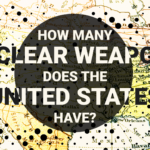Uncooperative threat reduction
By Fissile Materials Working Group | December 7, 2012
For more than two decades, the United States and Russia have worked together to secure Soviet stockpiles of nuclear, biological, and chemical weapons and materials, but now the future of this unprecedented partnership, the Cooperative Threat Reduction agreement, is in jeopardy. After several months of negotiations, Russian officials have publicly stated that they will not renew the current agreement, which forms the legal basis for cooperation between the two countries and is set to expire in July 2013. In early October, a Russian Foreign Ministry statement explained: “Our American partners know that their proposal is at odds with our ideas about the forms and basis for building further cooperation in that area. To this end, we need a more modern legal framework.” And yet, the Russian vision for the future is not clear.
American officials are stressing the national security value of Cooperative Threat Reduction programs and the administration’s sincere desire to continue working with Russia to reduce the vulnerability of weapons of mass destruction and related materials to theft, proliferation, and sabotage. US-Russian weapons security and dismantlement programs were created at the end of the Cold War and have been hailed as successful models of international cooperation for extremely sensitive security issues. Cooperative Threat Reduction collaborations underscore both the transnational nature of the weapons security threat and the ability of even the staunchest of adversaries to put aside other issues to address it. These are critical concepts to sustain.
The US Defense Department and the National Nuclear Security Administration (NNSA) spent nearly $650 million in 2012 on Russia-focused threat-reduction programs. Under the Obama administration’s 2013 budget request, this figure is closer to $500 million. Most of this funding is provided through the National Nuclear Security Administration, not the original suite of Defense Department programs that were created to deal with loose nukes in the early 1990s. The amount that the Defense Department invests in the program is not trivial, but the program has significantly diversified its focus to include threats outside Russia and to secure cooperation around global biosecurity. The NNSA’s International Nuclear Materials Protection and Cooperation program, which is responsible for nuclear material security in more than 40 nations, however, invested some $300 million in Russian activities in 2012 alone; this program will be devastated if the Cooperative Threat Reduction agreement lapses without a new accord in place. For 2013, the administration requested a dramatic cutback of the program’s global focus that would leave the initiative almost entirely — 70 percent — Russia-focused. It is clear that the United States had no intention of wrapping up threat-reduction activities with Russia next year.
What’s more, the exact nature of the changes to the agreement that Russia is seeking has not been publicized, but two issues stand out as likely candidates for change: liability and inspections. Liability provisions are a perennial cause of conflict between the two countries. The current agreement indemnifies the United States and its contractors for any damages or deaths incurred while carrying out threat-reduction work in Russia; an inability to resolve similar liability issues ultimately sank the Nuclear Cities Initiative, which helped support displaced Russian scientists in order to prevent security leaks, in 2003. On-site inspection rights are also historically contentious: The United States is currently permitted to inspect all materials and equipment it has provided Russia, but, with Russia now financially solvent, this level of transparency may no longer be acceptable to the country’s leaders, who have long chafed at verification measures as too intrusive.
To be sure, taken at face value, a call to amend the existing threat-reduction agreement and create “a more modern legal framework” is not unreasonable. President Obama and White House officials agree with the validity of such updating. The agreement was drafted in 1991, and the world and nature of the threat have changed significantly since then. In fact, moving away from a model in which the United States provides Russia with threat-reduction assistance and toward a model of equal partnership — in which the two share threat-reduction experiences and expertise with other countries to reduce global WMD dangers — would be a positive development and a successful evolution of the two nations’ work together.
Unfortunately, Russia has spoken only in generalities about the need to amend the agreement — without articulating the successor parameters it seeks. The question is not whether Russia has the resources to take over security measures in its territory, but whether it has the resolve. Russian leaders have been preoccupied with US missile defense plans and just last year announced that they were pulling out of a new scientist-redirection center in Moscow, which was created with US assistance to keep former weapons scientists’ skills off the black market. For an increasingly assertive and nationalistic Russia, “amending” the Cooperative Threat Reduction agreement may simply be a pretext for sending it the way of the recently ejected US Agency for International Development.
A fraying of US-Russian cooperation on weapons security programs would have serious negative repercussions, worldwide. In Russia itself, additional improvements and sustainability measures are still required to ensure that the dramatic strides in security made so far do not degrade over time. Russia is home to the world’s largest stockpiles of nuclear weapons and fissile materials; it also faces threats from separatist movements and illicit traffickers in the region. The United States is home to the second-largest stockpiles and shares a special responsibility with Russia to keep weapons and fissile materials safe and secure. American leaders recognize this. They stepped up with funding for the agreement when the Soviet Union collapsed and initiated the globally focused Nuclear Security Summit process in 2010.
Nuclear security is an ongoing challenge, and those who protect it must continually adapt to new threat environments. Today’s globalized threats require a multilateral response, but garnering action from the global community will be increasingly difficult if the powers with the largest material stockpiles cease to closely cooperate. The United States has publicized the value it places on continued cooperation with Russia, and now it is Russia’s turn to lay out a vision — hopefully one that provides for the future of nuclear security cooperation.
Editor’s note: This column was written by Michelle Cann, a member of the Fissile Materials Working Group and senior budget and policy analyst at the Partnership for Global Security.
Together, we make the world safer.
The Bulletin elevates expert voices above the noise. But as an independent nonprofit organization, our operations depend on the support of readers like you. Help us continue to deliver quality journalism that holds leaders accountable. Your support of our work at any level is important. In return, we promise our coverage will be understandable, influential, vigilant, solution-oriented, and fair-minded. Together we can make a difference.
Topics: Columnists, Nuclear Weapons















